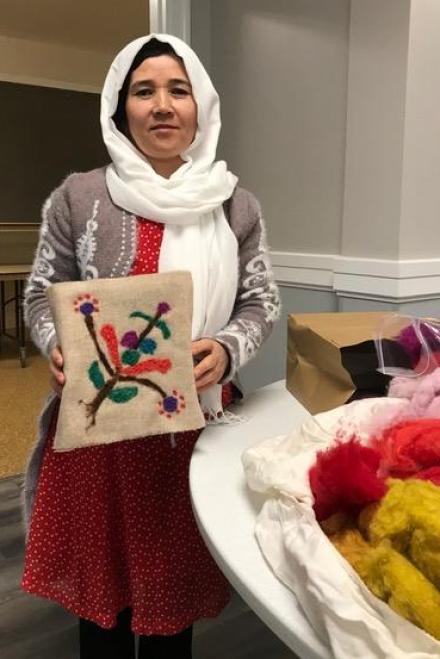
Khatima Darwishi is an expert, acutely focused embroiderer originally from Afghanistan who resettled in Worcester, MA about four and a half years ago. She markets greeting cards made of embroidery insets through RAW; she uses all the sales proceeds to help out her extended family with expenses. She and her immediate family now live in a new house in a town near Worcester. She speaks mostly the Dari language and is diligently studying English on a regular basis. One of her grown daughters (a community college student) served as our excellent English translator for a long interview in their comfortable home in July, 2022.
In contrast to our earlier talk with Khatima several years ago, when she told us that everything she did in America was for her daughters, not herself, nowadays she proudly claims her status as an adult learner, someone who enjoys studying new things. She well knows that many women and girls in Afghanistan today have no opportunity to go to school and to move around freely outside their homes.
Khatima told us in 2022 that she first learned to embroider cloth when she was seven years old in her home village in Afghanistan. An older sister taught her and they both knew that girls were expected to perfect their stitching skills before they got married at about age 20. A young woman had to know how to decorate her new home that she’d move to with her bridegroom: she would have to embroider “everything” for the home, including pillows, bed covers, curtains, wall decorations, table runners – everything.
She would be judged by family (both sides) and acquaintances by the quality of her embroidery. This has led to a certain competitiveness among women, regarding stitching technique, tightness of design, and creativity of motifs. In her talk with us Khatima averred that she preferred “the old designs” to more innovative ones. However, her embroidered insets that are used to decorate young women’s dresses (across the yoke) evidence a good deal of individual creativity on the part of the embroiderer.
During our conversation Khatima showed us a whole range of elaborately decorated and brightly colored dresses for her female kin, all with these fancywork sections inset across the yoke. These dresses are worn for festive events, such as weddings. Khatima also embroiders baby clothes for newborn relatives. These embroideries are separate from the ones she prepares for RAW to sell to the general public in Massachusetts.
In 2022 she also told us that she liked all the possible designs and all embroidery stitches, although the chain stitch is her favorite. It can be sewn quickly, making a design appear in short order. The most challenging thing in doing her embroidery? Making sure that her embroideries are not too big to use as the inset for a RAW greeting card. We all laughed at that; Ellen Ferrante of RAW attended this interview as well and smiled at this comment.
Khatima went on to tell us that embroidery thread from Afghanistan is by far the highest quality choice, over that made in India or the United States. “It is shinier” and produces a nice sheen on a pattern, she commented. She appreciates all colors of thread but gravitates toward the bright ones. For everyday wear, as an older married woman she herself dresses modestly, in a sedately crocheted Muslim head scarf and a long dress with long sleeves, in white or subdued colors.
Khatima recalled for us her childhood days when she was first learning to embroider. She liked learning new things and found that to be a good challenge. She could not go to regular school as that was thought to be unnecessary for girls. Girls were supposed to concentrate on domestic duties, such as cooking for the family and stitchery. Now in resettlement in Massachusetts, she sees doing embroidery at home as a “normal” thing to keep herself busy, not so much as an arena for learning new things. That is for language lessons.
It is interesting that she commented that she did not tend to learn much from any of the other non-Afghanistani embroiderers affiliated with RAW in Worcester. There are several from other nations in the city. Khatima does interact with other women from Afghanistan, however. She told us that, in general, she was very busy with doing embroidery to sell through RAW, with family duties, and with her English studies. For the latter sometimes she views programs on the household’s large television screen in their front room. Also of note: although homes in Afghanistan, as mentioned, are festooned with the mother’s embroidery work, Khatima’s house uses mostly American-style furnishings (sofas, chairs, throw rugs, kitchen island stools, with all the usual American middle class stainless steel appliances).
We asked her who she might hope would buy her embroideries that she brokers through RAW and she answered with a smile, “anyone” who might want to buy them. She considers her affiliation with RAW to be a practical arrangement that allows her to earn some cash, which she quicky turns into aid for her family. Very committed to self-reliance as a resettled refugee, Khatima is markedly enterprising in that way. She is soft-spoken yet full of quiet commitment to helping her family to succeed in diverse spheres. They have many challenges.
Items
Paine, Sheila. 2006. Embroidery from Afghanistan. Seattle: University of Washington Press, Fabric Folios Series.
